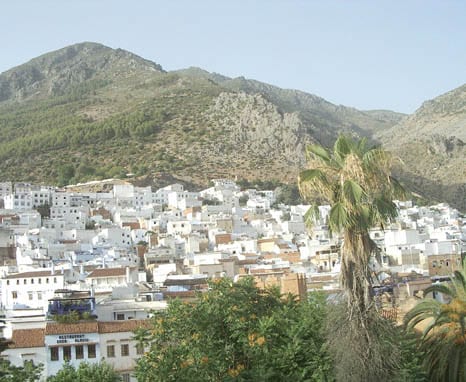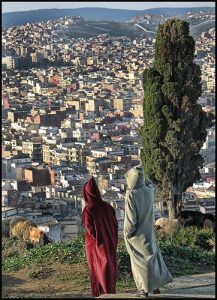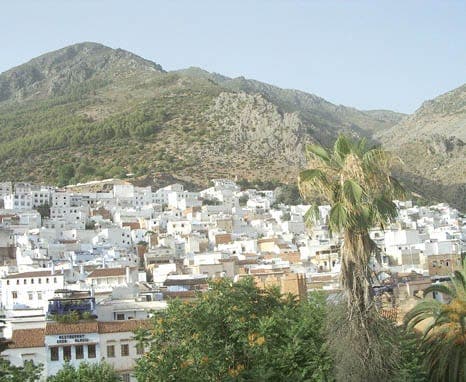CHANCES are, like many of the hundreds of thousands of northern Europeans who live in Andalucía, your idea of an adventure is a day trip to some perilously perched pueblo blanco or half an hour paragliding. Well, can I make a suggestion?
See that land mass shimmering on the horizon? That is Morocco, a country of rugs, riads and snake charmers. Now it is accessible as it is hip thanks to an incredibly quick new 35-minute hydrofoil service from Tarifa.
One part fashion shoot, one part giant bazaar, it has never been easier to spend a couple of days in the magical kingdom where Brad Pitt and Angelina, David Beckham and actor Orlando Bloom have recently been on holiday.
Sure, you have heard the stories about the rip off merchants, bag snatchers, ropey food and hygiene standards. And yes, you will have to be a little careful with what you eat – not to mention be prepared for something of a culture shock. But that is all part of the fun and if you take my advice as a regular visitor, you should avoid some of the obvious pitfalls and fall in love with Morocco’s vibrant colours, smells and breathtaking mountain scenery.
The key is your departure and arrival and where you go once you get there. First and foremost avoid the daytrips organised by every travel agent and hotel along the Costa del Sol. Like a conveyor belt, you will hardly have a chance to take a photo and will be a walking target for every hawker in town. Instead go under your own steam, avoiding the scruffy cesspool of Algeciras, from where most people depart, and take the fast ferry from the small port of Tarifa. Once you have arrived, the rules are simple. Save the frenetic city of Tangier for your return and head inland for a minimum one-night stay in the charming mountain town of Chefchaouen. This way you will become acclimatised to the country in the gentlest possible way; getting an idea of the customs – and perhaps most importantly – the goods and prices.

The adventure however begins in Spain, in the ancient walled town of Tarifa, which was once a key part of Muslim Europe. The first town to be conquered by the marauding Moors in 710 (it is named after Arab general Tarifibn Malluk), Tarifa is anchored to the foot of Spain and just eight miles from the tip of Africa. Well worth a poke around, it serves as an excellent introduction to Morocco. The ancient walled town was largely constructed by the Moors, who ruled this part of Spain until they were finally expelled in the 15th century.
While my passage across the infamously tricky Strait of Gibraltar was far smoother than that of the Moors, navigating Tangier’s border post was as ever complicated. Always at its worst at the height of summer when thousands of Moroccan ex-pats return for their holidays, it is usually a slow a relatively fraught process as “officials” vie for your custom with tussles, even punch ups, sometimes taking place between them. It pays to tip everyone – a five-euro note normally does the trick – and, above all, keep your sense of humour. It also helps to have someone like Asis waiting for you on the other side.
Something of a face in Tangier, the jovial six-foot-four tank of a man serves a dual purpose of sorting out arrangements on the ground as well as warding off any of the local hustlers. He will probably also tell you of his acquaintance with Ridley Scott, Orlando Bloom and others, having worked in the Moroccan film industry for years. He even has the photos to prove it.
Waving off Asis, within half an hour I was driving through rolling mountain scenery of pine, olive and cork woods, remarkably similar to southern Spain. Heading slowly into the breathtaking Rif Mountains, factories gave way to herds of goats and women in colourful robes and hats, some selling cactus fruit by the roadside. Like the Andalucía of legend, everyone seemed to have a donkey.
For me, the journey held particular interest, the route once being travelled by thousands of expelled Moors and Jews from Ronda (where I now live), who went on to settle in Chefchaoeun. Retracing their steps I wanted to compare and contrast the enduring architectural legacy they left behind in Spain with the mountain escape they went on to create. Arriving in Chaouen, as the locals call it, is always a curious sensation having first turned up on the bus for 20p, two decades earlier. A much needed escape after a whistle stop tour of the Imperial cities of Fes and Meknes, I will never forget how the excitement turned to irritation and rapidly to panic as a friend and I got attached to a particularly virulent hustler straight off the bus. We were easy prey, two fresh faces sixth formers on a week’s tour of Morocco and we were soon being led into the medina with the promise of the cheapest rooms available. Naturally, we ended up in a rabbit hutch with our
guide Abdul sitting on the end of the bed smoking the strongest marijuana cigarette imaginable.
Abdul was one of the many pushers who once gave the town a disturbing edge. We ended up paying him well over the odds to leave us in peace and woke up to find my personal stereo gone in the process. Thankfully, we did not see him again (we later heard he had been stabbed in a street fight) and went on to enjoy the stunning hill town, which was then only visited by a raggle-taggle band of hippy
travellers who gave the place a somewhat downbeat and dreary feel- How it has changed. No longer the scruffy, edgy hideaway it once was, today it is positively booming after a succession of makeovers. Now undoubtedly the gem of northern Morocco, the hustlers have either been bussed out of town or swapped their ounces and kilos for carpet shops. With the help of grants and joint projects with Andalucía – involving the twinning of Chaouen with Ronda – the place manages to be both alive and laid back in the same breath.
Feeling blue? This is the place to pick up your spirits. A tightly wound mountain town skirting a pine forest and soaring peaks (the name Chefchaouen means “to look at the peaks”), thanks to its Jewish roots most of its houses and narrow streets are painted blue: a bright optimistic blue that lets the spirits soar.
Atmospheric even on wet winter days, the town was founded in 1471 by Ali Ben Rachid, a celebrated Muslim warrior who had made his name fending off the Christians around Granada. Retreating to Morocco, he sited the town above the strategic trading route from
Fes to Tetuan in the north, building the Alcazaba castle to secure its position. By 1492, with the Kingdom of Granada falling, there was a huge influx of both Arabs and Jews.
In 1609, when Spain expelled anyone with non-Christian roots, the town came into its own.
Little has changed since then and the influence of the Moors in Chaouen is very obvious, from various surviving archways to the style of courtyard houses – which can only be entered by one, often tiny, exterior door. Take a wander around starting in the shady, cobbled plaza Uta el-Hammam, in which you will find dozens of restaurants and shops as well as the main castle. Look out in particular for the ancient funduq, where weary travellers laid their heads.

Next head off in any direction and get lost in the medina, before taking a stroll in the mountains.
People are surprisingly friendly and the shops will not put you under any pressure to buy.
Above all, remember to always offer at half – or less – of the original asking price and do not be scared to sit down and negotiate over a cup of mint tea, a favourite local custom.
Having learnt a little about haggling you will be prepared to dip into Tangier on your way back. Having dropped off the hire car and with the towering figure of Asis back by my side, we entered the ancient medina via a sneaky back way beside the port. I had soon negotiated
ten copper light covers for less than three euros each and a classic silk rug for 60 euros. Armed with market prices, I could – up to a point – offer the traders what I thought things were worth. Most bit my hand off, but a few refused to sell at low prices on principle. One, sure that I would be back for a delightful pair of brass lamps actually put the price up. And, of course, his gamble paid off. I returned an hour later to pay nearly 80 euros for them before running to catch the last ferry home.

